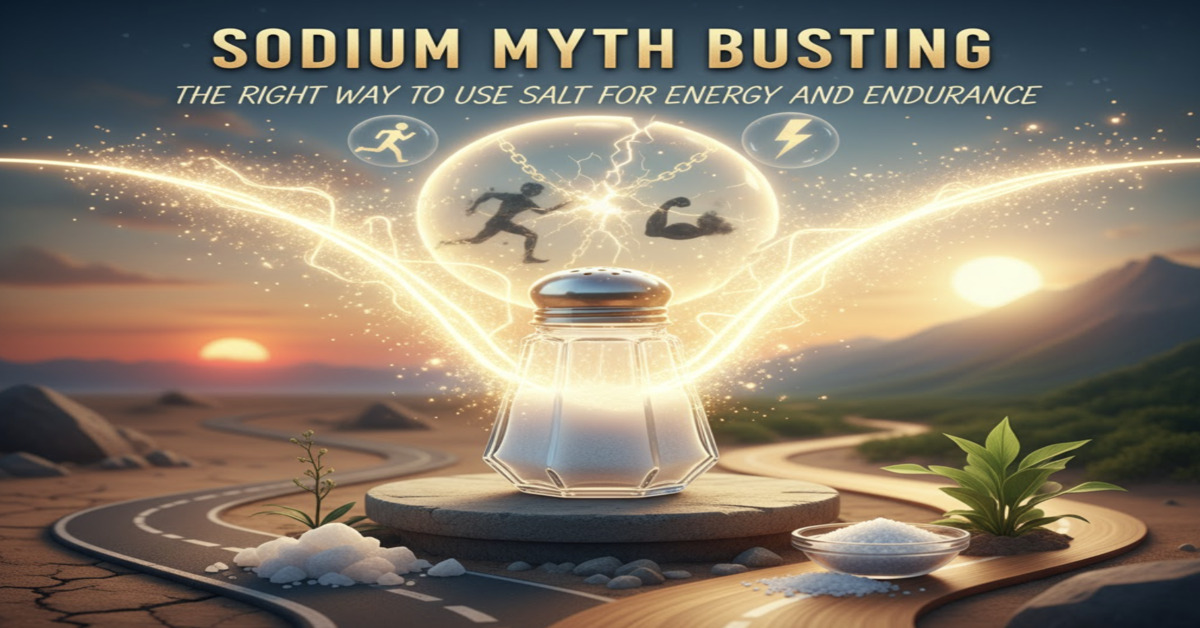Introduction: Rethinking Sodium in Modern Nutrition
For decades, sodium has been painted as the villain of modern nutrition—blamed for hypertension, bloating, and cardiovascular risk. But emerging evidence suggests that excessive sodium restriction may do more harm than good, especially for active individuals and endurance athletes.
In reality, sodium is an essential electrolyte that regulates fluid balance, nerve function, and muscle contraction. The key lies in balance, not avoidance.

The Science of Sodium: Why It’s Not the Enemy
Sodium is one of the body’s most critical electrolytes, maintaining extracellular fluid volume and osmotic balance. It directly influences how cells communicate, how muscles contract, and how efficiently the body retains water.
Contrary to outdated advice, low-sodium diets can impair performance, decrease energy, and trigger symptoms like fatigue, headaches, and muscle cramps.
Statistic: A 2023 study in Frontiers in Nutrition found that athletes consuming under 2g of sodium daily showed 17% reduced endurance capacity compared to those consuming 3–5g.

The Real Dangers of Sodium Deficiency
While excess sodium can elevate blood pressure in sensitive populations, deficiency can be equally damaging.
Symptoms of low sodium (hyponatremia):
- Headaches and dizziness
- Fatigue and nausea
- Low blood pressure and poor circulation
- Muscle weakness and cramping
- Impaired focus and brain fog
Expert quote:
“Chronic sodium deficiency is a hidden cause of fatigue and exercise intolerance—especially in those following clean or low-salt diets,” says Dr. Alan Rhodes, Sports Medicine Specialist.
Sodium and Physical Performance
During exercise, sodium loss through sweat can range from 1,000–2,500 mg per hour. Without proper replenishment, performance and thermoregulation suffer.
Benefits of adequate sodium intake for performance:
- Maintains plasma volume and hydration
- Prevents early fatigue and muscle cramps
- Supports nerve transmission and muscle recovery
- Enhances nutrient absorption
Sodium Balance and Hydration
Hydration isn’t just about water. Sodium helps retain fluids within cells, preventing over-dilution that leads to hyponatremia.
Key takeaway: Overhydration without adequate electrolytes can be just as harmful as dehydration.
Hydration ratio rule:
For every liter of water, include 500–800 mg of sodium, especially in high-sweat conditions.
Statistic: The American College of Sports Medicine (2024) recommends 300–700 mg of sodium per hour during endurance events to maintain optimal hydration.
Common Sodium Myths Debunked
| Myth | Reality |
|---|---|
| Sodium causes hypertension in everyone | Only 25–30% of the population is sodium-sensitive |
| All processed food sodium is bad | Context matters — high-quality sea salt and electrolyte mixes differ from sodium in junk foods |
| Athletes should avoid salt | Endurance athletes often need more sodium, not less |
| Low-sodium diets are universally healthy | May cause hormonal imbalances and fatigue |
| You can replace sodium just with water | Water alone dilutes sodium and increases cramp risk |
Sodium Intake Guidelines: What Science Says
- General population: 2,300 mg/day (USDA recommendation)
- Active individuals: 3,000–5,000 mg/day
- Endurance athletes: Up to 7,000 mg/day (depending on sweat loss and climate)
Expert quote:
“Individual sodium needs depend on sweat rate, diet, and activity. For most active Americans, moderate sodium intake enhances—not harms—health,” says Dr. Michelle Garza, Registered Dietitian and Performance Nutritionist.
Practical Sodium Strategies for Active Americans
- Use electrolyte tablets or powders during intense workouts.
- Add mineral-rich sea salt or Himalayan pink salt to meals.
- Don’t skip salt when following low-carb or ketogenic diets.
- Replenish sodium after long runs or sauna sessions.
- Pair sodium with potassium and magnesium for electrolyte balance.
Suggested image placement: Athlete refueling post-workout with a balanced meal containing salt, avocado, and water.
Checklist: Optimal Sodium Management
☑ Hydrate with electrolytes, not just water
☑ Salt meals lightly, especially pre- and post-workout
☑ Avoid ultra-processed high-sodium junk foods
☑ Use real salts (sea salt, Celtic, or Himalayan)
☑ Adjust intake based on sweat rate and season
Sodium Sources Table
| Food | Serving | Sodium (mg) |
|---|---|---|
| Pickles | 1 spear | 280 |
| Sea Salt | 1/4 tsp | 575 |
| Cottage Cheese | ½ cup | 400 |
| Olives | 10 large | 400 |
| Chicken Broth | 1 cup | 860 |
| Salted Almonds | 1 oz | 150 |
Expert Insights on Sodium and Endurance
“Most Americans hear ‘cut salt,’ but active individuals need the opposite message. Electrolyte balance fuels recovery and mental sharpness,” says Dr. Sandra Lewis, Exercise Physiologist.
“Proper sodium replenishment reduces injury risk, maintains blood volume, and enhances long-term cardiovascular performance,” adds Dr. Dean Peters, Sports Cardiologist.
Common Myths & FAQ
Q1: Should I worry about sodium if my blood pressure is normal?
A: No. If you’re active and eat a balanced diet, moderate sodium supports hydration and energy.
Q2: Can sea salt or pink salt replace table salt?
A: Yes. They contain trace minerals, though sodium levels are comparable.
Q3: How can I tell if I need more sodium?
A: Persistent fatigue, dizziness, and salt cravings often indicate deficiency.
Q4: Is sodium bad for the heart?
A: Excess processed sodium is harmful, but natural salt in balance supports heart rhythm and function.
Authoritative Resources
- American College of Sports Medicine – Exercise and Fluid Balance
- National Institutes of Health – Sodium and Health
Other Interesting Articles
- Psychobiotics: The New Gut Supplements for Stress, Anxiety, and Focus
- Menopause Muscle Loss: Strength Training Protocols That Actually Work
Conclusion & Call-to-Action
Sodium isn’t your enemy—it’s your body’s most underappreciated performance ally. Instead of fearing salt, learn to use it intelligently to boost energy, enhance hydration, and improve endurance.
Action Step:
Start by tracking your sodium intake for one week. If you’re active or frequently fatigued, increase your intake modestly with quality salts and hydration strategies. Balance—not restriction—is the real key to optimal performance and longevity.

